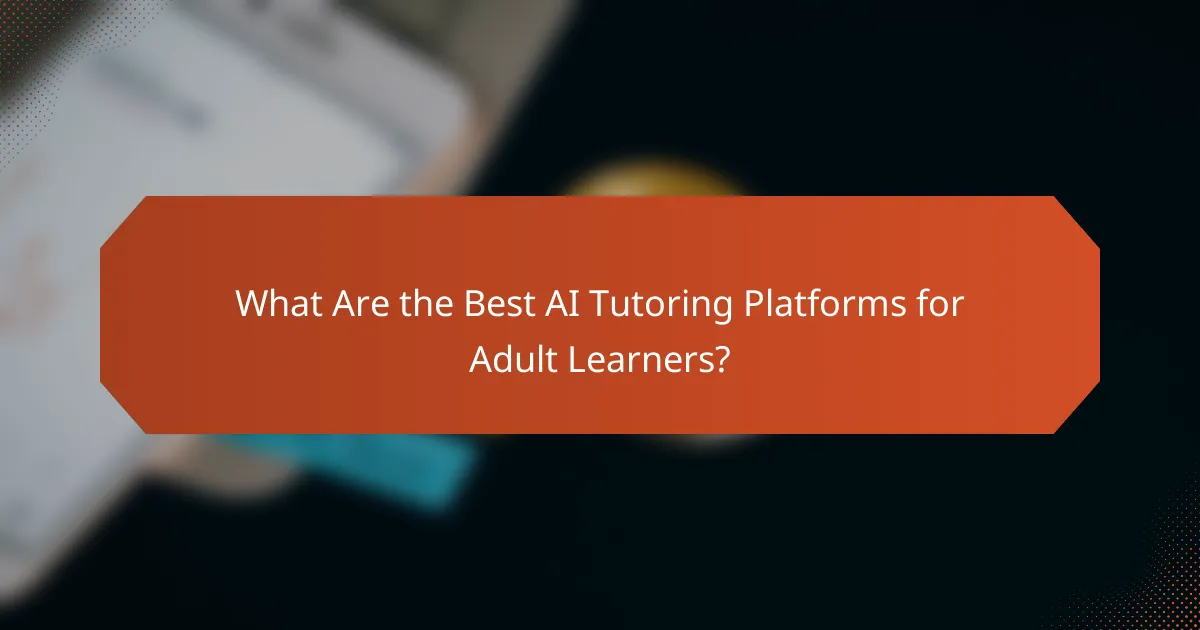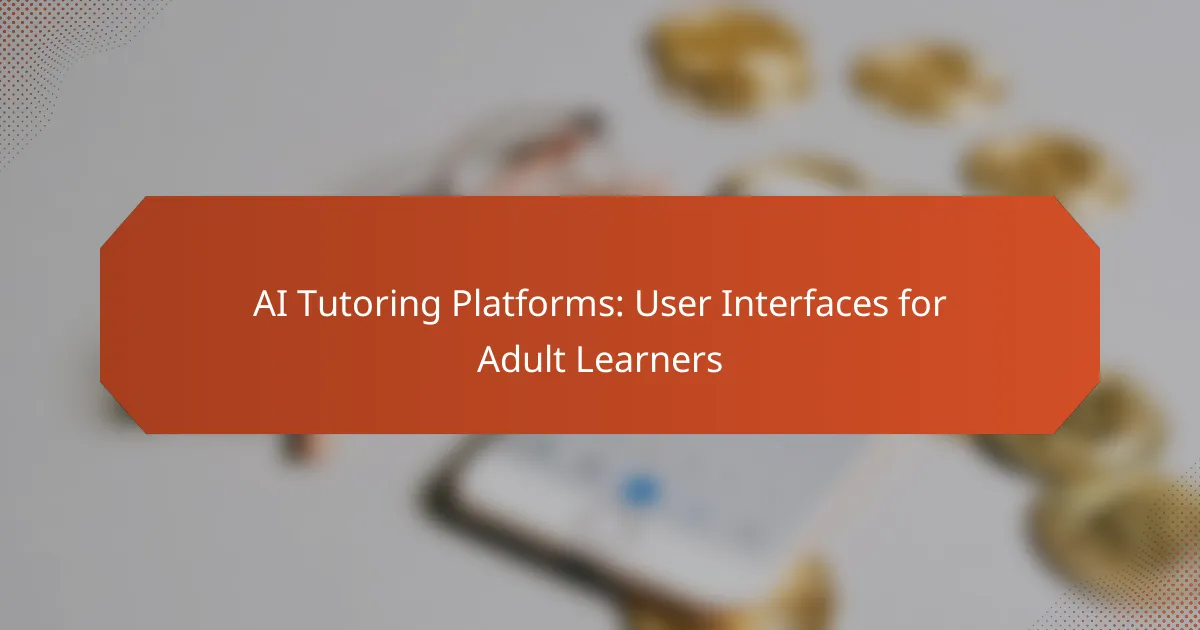AI tutoring platforms for adult learners, such as Coursera and LinkedIn Learning, utilize artificial intelligence to create tailored educational experiences that meet individual goals. The effectiveness of these platforms is heavily influenced by their user interfaces, which facilitate navigation and interaction, ultimately enhancing engagement and learning outcomes.

What Are the Best AI Tutoring Platforms for Adult Learners?
The best AI tutoring platforms for adult learners include Coursera, edX, Udacity, Skillshare, and LinkedIn Learning. These platforms leverage artificial intelligence to provide personalized learning experiences, catering to the specific needs and goals of adult students.
Coursera
Coursera offers a wide range of courses from top universities and organizations, utilizing AI to recommend courses based on user interests and learning history. Adult learners can benefit from flexible scheduling, allowing them to learn at their own pace while accessing high-quality content.
Key features include interactive quizzes and peer-reviewed assignments, which enhance engagement. Consider exploring specializations or professional certificates that can boost your career prospects.
edX
edX provides access to university-level courses with a focus on professional development. Its AI-driven platform suggests courses tailored to individual learning paths, making it suitable for adult learners seeking to upskill or change careers.
With options for verified certificates, edX allows learners to showcase their achievements to potential employers. Look for MicroMasters programs if you want to gain in-depth knowledge in a specific field.
Udacity
Udacity specializes in tech-related fields, offering nanodegree programs designed with input from industry leaders. The platform uses AI to personalize learning experiences, ensuring that adult learners receive relevant content that aligns with job market demands.
Courses often include real-world projects and mentorship opportunities, which can be valuable for practical learning. Keep in mind that Udacity’s programs may require a financial commitment, so assess your budget before enrolling.
Skillshare
Skillshare focuses on creative skills and personal development, making it a great option for adult learners interested in arts, design, and entrepreneurship. The platform employs AI to recommend classes based on user preferences and engagement levels.
Membership provides unlimited access to thousands of classes, allowing learners to explore various topics. Consider joining community discussions to enhance your learning experience and network with peers.
LinkedIn Learning
LinkedIn Learning offers a vast library of courses aimed at professional development, utilizing AI to suggest content based on your LinkedIn profile and career interests. This makes it particularly useful for adult learners looking to enhance their skills for career advancement.
Courses are often short and focused, ideal for busy professionals. Take advantage of the platform’s integration with LinkedIn to showcase completed courses on your profile, increasing visibility to potential employers.

How Do User Interfaces Impact Adult Learning?
User interfaces significantly influence adult learning by shaping how easily learners can navigate educational content and interact with the platform. A well-designed interface enhances engagement, reduces frustration, and ultimately supports better learning outcomes.
Intuitive Navigation
Intuitive navigation is crucial for adult learners, as it allows them to find information quickly without feeling overwhelmed. Clear menus, logical content organization, and recognizable icons help users move through the platform efficiently. For example, a consistent layout across pages can reduce the time spent searching for resources.
To improve navigation, consider implementing breadcrumb trails, search functionality, and easily accessible help sections. Avoid cluttered designs that can confuse users, and prioritize essential features that directly support learning goals.
Responsive Design
Responsive design ensures that AI tutoring platforms function well across various devices, including smartphones, tablets, and desktops. This flexibility is vital for adult learners who may access content on the go or from different environments. A responsive layout adapts to screen sizes, providing a seamless experience regardless of the device used.
When designing for responsiveness, prioritize touch-friendly elements and ensure that text remains legible on smaller screens. Regularly test the platform on multiple devices to identify and address any usability issues that may arise.
Accessibility Features
Accessibility features are essential for accommodating diverse learning needs among adult learners. These features include screen reader compatibility, adjustable text sizes, and alternative text for images. By adhering to accessibility standards, such as the Web Content Accessibility Guidelines (WCAG), platforms can create inclusive learning environments.
Consider offering options for high-contrast themes and keyboard navigation to support users with visual impairments or mobility challenges. Regularly gather feedback from users with disabilities to identify areas for improvement and ensure that the platform remains user-friendly for everyone.

What Features Should Adult Learners Look for in AI Tutoring Platforms?
Adult learners should seek AI tutoring platforms that offer personalized learning paths, real-time feedback, interactive content, and community support. These features enhance the learning experience by catering to individual needs and fostering engagement.
Personalized Learning Paths
Personalized learning paths allow adult learners to progress at their own pace, focusing on areas where they need improvement. This customization can be based on initial assessments or ongoing performance metrics, ensuring that each learner receives tailored content that matches their skill level and learning style.
When evaluating platforms, look for those that adapt the curriculum based on user interactions and achievements. For example, if a learner struggles with a specific topic, the platform should provide additional resources and exercises to reinforce understanding.
Real-Time Feedback
Real-time feedback is crucial for adult learners to understand their progress and areas needing attention. AI tutoring platforms should provide instant evaluations of quizzes and assignments, allowing learners to adjust their study strategies promptly.
Consider platforms that offer detailed analytics on performance, highlighting strengths and weaknesses. This immediate feedback loop can significantly enhance learning efficiency, as learners can quickly identify and address gaps in their knowledge.
Interactive Content
Interactive content engages adult learners more effectively than traditional methods. Look for platforms that incorporate multimedia elements such as videos, simulations, and gamified learning experiences to make the material more engaging and easier to understand.
For instance, platforms that use scenario-based learning can help learners apply concepts in real-world situations, making the learning process more relevant and practical. This approach not only boosts retention but also keeps learners motivated.
Community Support
Community support is vital for adult learners, as it fosters collaboration and peer interaction. AI tutoring platforms should facilitate forums, discussion groups, or live chat options where learners can ask questions, share experiences, and provide mutual encouragement.
When choosing a platform, assess the community features available. A strong support network can enhance motivation and provide additional resources, making the learning journey less isolating and more enriching.

How Do Pricing Models Differ Among AI Tutoring Platforms?
AI tutoring platforms typically offer various pricing models, including subscription-based, pay-per-course, and free trials. Each model has its own advantages and considerations, making it essential for adult learners to choose one that aligns with their learning goals and budget.
Subscription-Based
Subscription-based pricing allows users to pay a recurring fee, often monthly or annually, for access to a range of courses and resources. This model is beneficial for learners who plan to take multiple courses over time, as it can lead to cost savings compared to purchasing individual courses.
When considering a subscription, look for platforms that offer flexible plans, such as family or group subscriptions, which can further reduce costs. Be aware of cancellation policies, as some platforms may require advance notice to avoid being charged for the next billing cycle.
Pay-Per-Course
Pay-per-course models charge users a one-time fee for each course they enroll in. This approach is ideal for learners who prefer to take courses on an as-needed basis without committing to a long-term subscription. Prices can vary widely, typically ranging from around $30 to several hundred dollars depending on the course content and provider.
Before enrolling, check if the platform offers any bundled courses or discounts for purchasing multiple courses at once. Additionally, verify if there are any hidden fees, such as materials or certification costs, that could increase the total expense.
Free Trials
Many AI tutoring platforms provide free trials, allowing users to explore the platform and its offerings without financial commitment. These trials typically last from a few days to a couple of weeks and can help learners assess the quality of the content and the user interface.
Take advantage of free trials by fully engaging with the available courses and resources. Make sure to note the trial’s expiration date to avoid being charged unexpectedly. If you find the platform beneficial, consider whether a subscription or pay-per-course model suits your long-term learning needs best.

What Are the Challenges of Using AI Tutoring Platforms for Adults?
Adults face several challenges when using AI tutoring platforms, including usability issues, lack of personalized learning experiences, and varying levels of digital literacy. These factors can hinder effective learning and engagement, making it essential to address them for successful outcomes.
Usability Issues
Many AI tutoring platforms are designed with younger users in mind, which can lead to complex interfaces that confuse adult learners. Adults may struggle with navigation and functionality, particularly if they are not tech-savvy. Simplifying the user interface and providing clear instructions can significantly enhance the learning experience.
To improve usability, platforms should prioritize intuitive design and offer tutorials or onboarding sessions. Providing options for customization can also help adults tailor the experience to their preferences, making learning more accessible.
Lack of Personalized Learning Experiences
AI tutoring platforms often rely on algorithms that may not fully account for the unique backgrounds and learning styles of adult learners. This can result in generic content that fails to engage or meet individual needs. Personalization is crucial for effective learning, as adults often have specific goals and motivations.
Platforms should incorporate adaptive learning technologies that adjust content based on user performance and preferences. Regular feedback and assessments can help ensure that the learning path remains relevant and challenging for adult learners.
Varying Levels of Digital Literacy
Adult learners come with diverse levels of digital literacy, which can impact their ability to effectively use AI tutoring platforms. Some may be comfortable with technology, while others may require additional support and training. This disparity can create barriers to learning and engagement.
To address this challenge, platforms should offer resources that cater to different skill levels, such as beginner guides or video tutorials. Encouraging peer support and community forums can also help bridge the gap for those who may need extra assistance navigating the technology.
